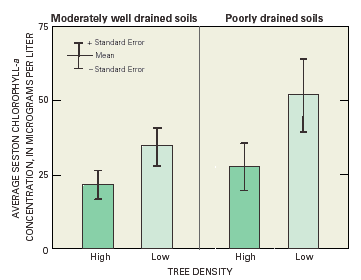
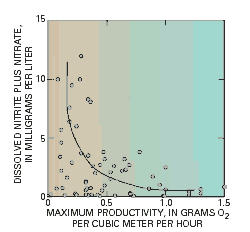
Previous Section: Natural Factors Influence Chemical Indicators of Water Quality
Next Section: Implications for Water-Quality Monitoring and Assessment
Return to Table of Contents
Return to Home Page
Algal seston (phytoplankton; algae suspended in the water) can be an indicator of the amount of total nutrients and organic enrichment in Midwestern streams during low-flow conditions, such as those during August 1997. Organic enrichment from excessive algal production can increase rates of microbial respiration in streams, reducing dissolved oxygen (DO) to concentrations that are detrimental for sensitive invertebrate and fish species. Rates of dissolved nutrient uptake by algae and other aquatic plants are closely associated with rates of primary production (Borchardt, 1996). Streams with low tree density in riparian segments contained relatively large growths of algal seston at levels considered indicative of eutrophication (Porter, 2000). The relative abundance of algal seston, as measured by chlorophyll-a (CHLa) concentrations, was largest in streams with low tree density in basins with poorly drained soils (fig. 9). In addition, seston CHLa concentrations were positively correlated with total organic nitrogen and carbon concentrations in water samples, as well as maximum rates of stream productivity (Pmax) and respiration (Rmax) (Porter, 2000; Sorenson and others, 1999). Concentrations of dissolved nitrogen in Midwestern streams decreased with increases in seston CHLa and Pmax (fig. 10), and mean dissolved orthophosphate concentrations were smallest in poorly shaded streams in basins with poorly drained soils (fig. 4) where seston CHLa (fig. 9) and Pmax were higher. Thus, shading from tree cover in riparian segments can influence nutrient concentrations in streams indirectly by reducing the growth of algal seston and rates of stream metabolism.
 |
 |
| Figure 9. The relative abundance of algal seston was greater in streams with a low density of trees in the riparian segment. | Figure 10. Concentrations of dissolved nitrogen decreased with increasing stream productivity. |
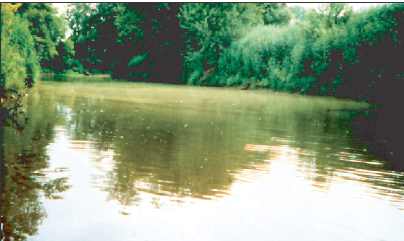
Periphyton (algae attached to submerged tree branches and logs) abundance was largest in streams draining the Dissected Till Plains section (fig. 11), where water clarity and riparian tree density generally were high (Porter, 2000), soils were moderately well drained, and ground-water contributions to streamflow were appreciable (Winter and others, 1998). Streams with above-average periphyton CHLa (but low seston CHLa) were productive; however, rates of stream respiration were relatively low (Porter, 2000). The composition of periphyton communities (fig. 12) varied from a dominance of diatoms, a desirable food source for invertebrates and fish, to blue-green algae, which are not consumed. The percentage of blue-green algae in the periphyton community increased with the concentration of total triazine-herbicide compounds and was larger in streams with large amounts of algal seston (Porter, 2000). As expected, average periphyton biomass was smaller in streams with a large abundance of benthic invertebrates that consume algae (scrapers) (fig. 13).
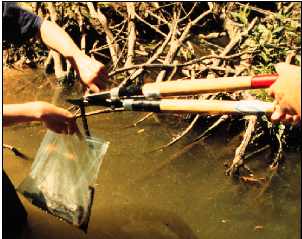 |
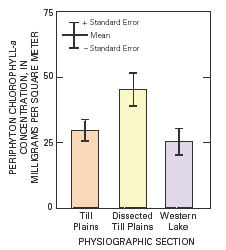 |
| Figure 11. Average periphyton abundance was largest in streams of the Dissected Till Plains section. |
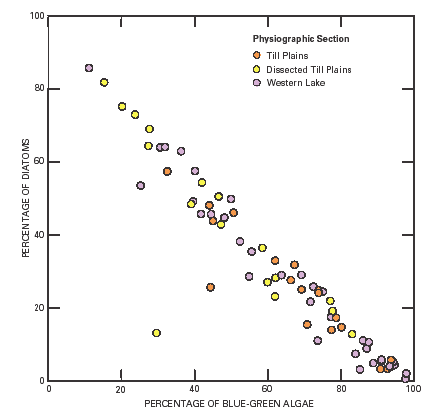 |
| Figure 12. Periphyton community structure varies from a predominance of diatoms to blue-green algae in Midwestern streams and rivers. |
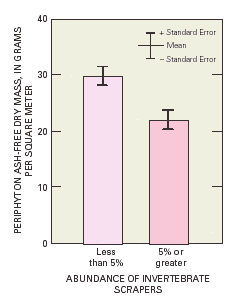 |
 |
| Figure 13. Average periphyton biomass was smaller in streams with a large abundance of invertebrates that consume algae. |
Benthic invertebrate communities were influenced by stream velocity, minimum DO concentrations, tree density in the sampling reach, and the abundance of periphyton. The composition of invertebrate communities (fig. 14) varied from a dominance of EPT taxa (mayflies, stoneflies, and caddisflies), which are relatively sensitive to organic enrichment, to a group of taxa (midges, true flies, beetles, and worms) considered to be tolerant of organic enrichment and resultant low DO concentrations (Klemm and others, 1990; Johnson and others, 1993). Sensitive stream invertebrates, such as EPT taxa, require flowing waters with high oxygen content to survive. Invertebrate indicators of water-quality degradation in many Till Plains streams may have been responding more to stresses associated with low-flow conditions than any substantial differences in agricultural intensity across the upper Midwest. Below average basin water yield and stream velocity (fig. 15) in the Till Plains basins probably were a result of relatively low rainfall (fig. 3) prior to August 1997, the month of sample collection. Minimum DO concentrations in these streams were lower than in the other physiographic sections, and rates of stream metabolism (notably Rmax) were higher (fig. 16), indicative of organic enrichment. Relatively fewer invertebrate taxa were found in streams in the Western Lake section (Sorenson and others, 1999; Mitchell Harris, written commun., 2000), despite favorable velocity and DO conditions. Extended (and variable) high streamflow conditions in the section during spring and early summer 1997 (USGS streamflow data; Porter, 2000), associated with above-average rainfall (fig. 3), may have been unfavorable for species that are unable to withstand hydrologic disturbances.
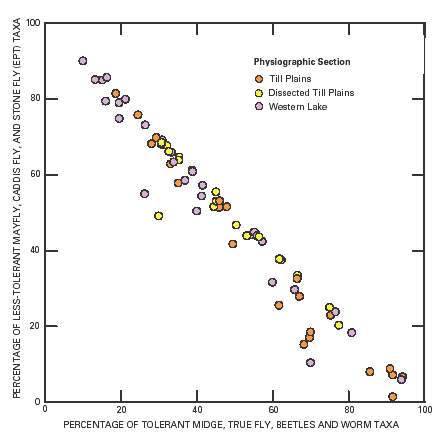 |
| Figure 14. Benthic invertebrate community composition and tolerance to organic enrichment varies among Midwestern streams and rivers. |
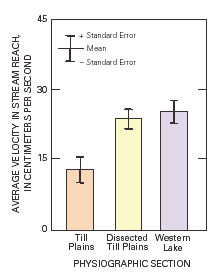 |
| Figure 15. Average velocity was slowest in Till Plains streams, probably because of less rainfall and water yield in those basins prior to the date of sampling. |
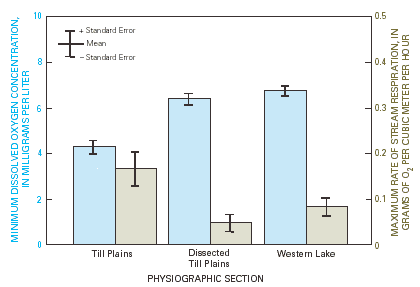 |
| Figure 16. Minimum dissolved oxygen concentrations were associated with higher rates of stream metabolism in the Till Plains physiographic section. |
In general, biological indicators represented better water quality in Midwestern streams with riparian zones characterized by high tree density, particularly when velocity and DO conditions were favorable. Overall, the number of invertebrate taxa was over 20 percent larger in streams with high tree density along the sampling reach (fig. 17). Submerged woody debris in these streams enhances the complexity of aquatic habitats, and seasonal leaf fall into the streams, in addition to the periphyton, provides diverse food resources. In a related study, Stauffer and others (2000) also found that fish communities indicated better overall conditions in agricultural streams with wooded riparian zones than those with more open canopy.
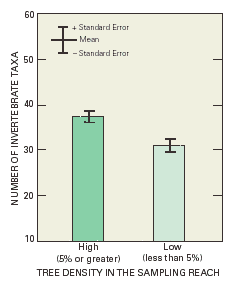 |
|
Figure 17. More invertebrate taxa were found in streams with high tree density than in streams with low density. |
| AccessibilityFOIAPrivacyPolicies and Notices | |
 |
|